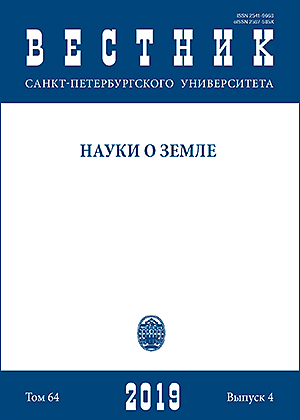Кис-Кюельское Fe-Cu-Au ± (Ag, Mo, Bi) месторождение в Восточной Якутии (Россия): связь между железо-оксидными медно-золотыми и связанными с интрузиями золоторудными системами
DOI:
https://doi.org/10.21638/spbu07.2019.401Аннотация
Класс железо-оксидных медно-золотых (IOCG) включает в себя генетически слабо связанные месторождения с совокупностью общих признаков. Одно из них локализовано в Кис-Кюельском интрузиве (Восточная Якутия, Россия) и характеризуется широким спектром минеральных парагенезисов, имеющих прямую генетическую связь со становлением интрузива. Руды имеют общие черты месторождений IOCG типа - обилие оксидов железа и небольшое количество сульфидов. Рудовмещающие интрузивные породы по составу варьируются от диорита до гранодиорита. Редкоземельная геохимическая система магматических пород интрузива Кис-Кюель характеризуется поведением, близким к CHARge (заряд)-и-Radius (радиус)-контролируемой системе CHARAC (26 < Zr/Hf < 46 и 24 < Y/Ho < 34), в которой отношения Y/Ho - Zr/Hf пары показывают распределение, близкое к хондриту (Zr/Hf - 36,6 и Y/Ho - 27,7). Незначительные отклонения пород от интервалов CHARAC указывают на низкий уровень эволюции магматической системы. Рудная минерализация была обнаружена в кровле интрузивного массива и включает несколько минеральных типов. Железо-оксидный медно-золотой и медно-порфировый представлены брекчиями в ореоле ороговикованных и интрузивных пород с FeOX - 13,58-63,24%; Cu - 0-3,57%; Au - 12,93-64,48 г/т; Ag - 2,7-830 г/т. Ассоциирущие с IOCG кварц-гематит-галенитовые жилы содержат Ag - 22,4-3680 г/т; Cu - 0,014-0,534%; Pb - 0,1-81,63%. Массивы листоватых железистых кварцевых жил с арсенопиритом, самородным золотом и висмутом, а также Ag-Bi-сульфосолями содержат Au - 0,15-4,6 г/т; Ag - 20,6-196 г/т; Cu - 0,048-0,24%; Pb - 0,3-3,73%. Статья посвящена Кис-Кюельскому месторождению, связанному с диорит-гранодиоритовым интрузивом в Восточной Якутии (Россия). Оно рассматривается как связанное с интрузией (IRGD) комплексное месторождение золота, в котором основным компонентом являются руды IOCG типа и второстепенным - Cu-Au-порфирового.
Ключевые слова:
Восточная Якутия, Кис-Кюельский рудный узел, Железо-оксидное медно-золотое месторождение, связанное с интрузивом, поиск золота
Скачивания
Библиографические ссылки
References
Загрузки
Дополнительные файлы
Опубликован
Как цитировать
Выпуск
Раздел
Лицензия
Статьи журнала «Вестник Санкт-Петербургского университета. Науки о Земле» находятся в открытом доступе и распространяются в соответствии с условиями Лицензионного Договора с Санкт-Петербургским государственным университетом, который бесплатно предоставляет авторам неограниченное распространение и самостоятельное архивирование.






